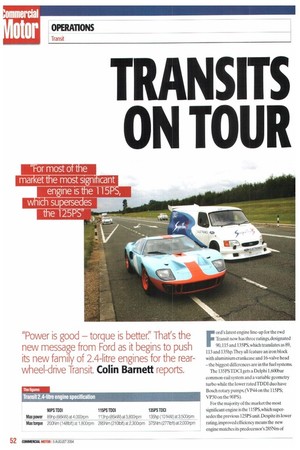TRANSITS ON TOUR
Page 54

Page 55

If you've noticed an error in this article please click here to report it so we can fix it.
"Power is good — torque is better That's the new message from Ford as it begins to push its new family of 2.4-litre engines for the rear wheel-drive Transit Colin Barnett reports.
Ford's latest engine line-up for the rwd 11.ansit now has three ratings, designated 90,115 and 135PS, which translates as 89, 113 and 135hp.They all feature an iron block with aluminium crankcase and 16-valve head —the biggest differences are in the fuel systems.
The 135PS TDCI gets a Delphi 1,600bar common-rail system and a variable geometry turbo while the lower rated TDD1 duo have Bosch rotary pumps, (VP44 on the 115PS; VP30 on the 90P8).
For the majority of the market the most significant engine is the 115PS,which supersedes the previous 125PS unit. Despite its lower rating,improved efficiency means the new engine matches its predecessor's 285Nm of torque.The 135PS variant has an impressive 375Nm on tap.
The two lower powered engines are set to attract most buyers: Ford believes the 115PS version offers the best all-round combination of performance and economy. But it fully appreciates the task it faces in convincing sceptical fleet buyers to spend an extra £600 on the extra power.
To help it put the latest engines to a practical test,we met up with Ford at Brands Hatch to take a variety of Transits on a cross-Channel expedition.
Following a sprint down the M20 and through the tunnel we followed a predominantly autoroute journey down to the Normandy resort of Etretat,j ust short of Le Havre. CM teamed up with Ford's engineers for a serious appraisal. On the outward journey we drove a 90PS van with our every move shadowed by the Ford men in a 110PS; we swapped over for the return leg.
The two vans had identical half-loads and both came with Ford's favoured final drive ratio for the power output —4.27:1 on the 115PS and 4.63:1 on the 90PS.
The most significant factor in the exercise turned out to he climatic, as both sides of the Channel experienced the strongest winds for some years. Obviously the wind prevented truly representative figures being obtained but we did reach some interesting conclusions.
Ford's own figures around CM 's Kent van route showed the 115PS to have a 6% fuel advantage over the 90PS. On our outbound trip winds,predominantly head on, were strong enough to force us to settle for an autoroute target speed of 110km/h on safety grounds. Hence the higher powered Transit's fuel consumption was 7.54% better than the 90PS.
On the return journey the next day. the wind was still strong and from the same direction but it had subsided enough to allow the speed limit of 130km/h to be maintained relatively safely. Not surprisingly, the consumption of both vans improved, but the easier running provided by having the wind up our exhaust pipes reduced the 115's advantage tojust 1.06%.
Over the 425 mile round trip the 115PS proved 4.23% more fuel efficient.


































































































































































































